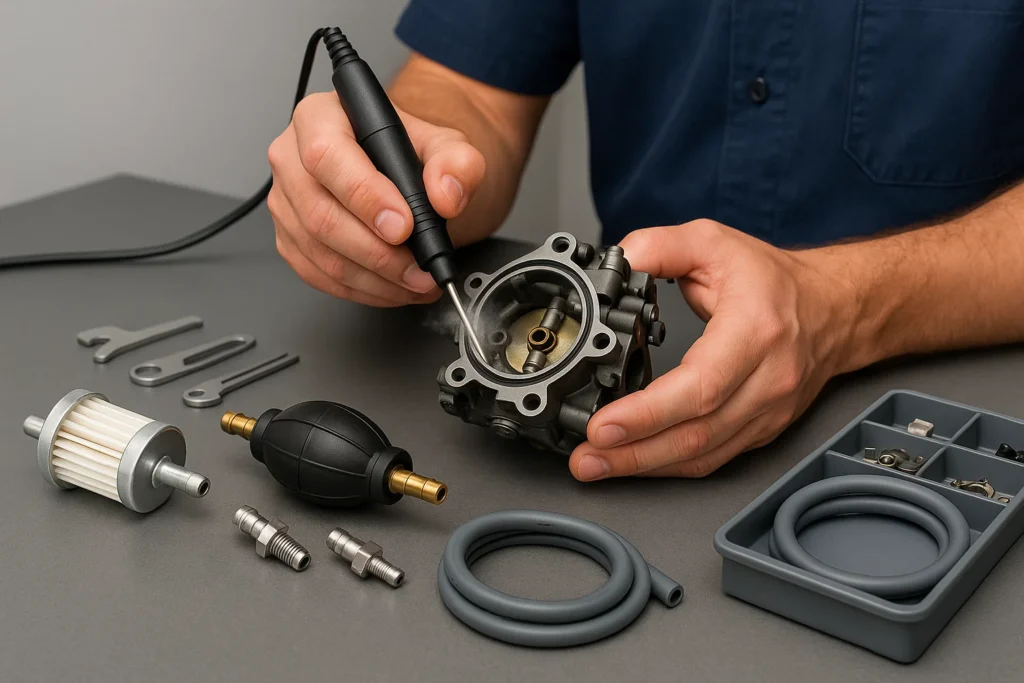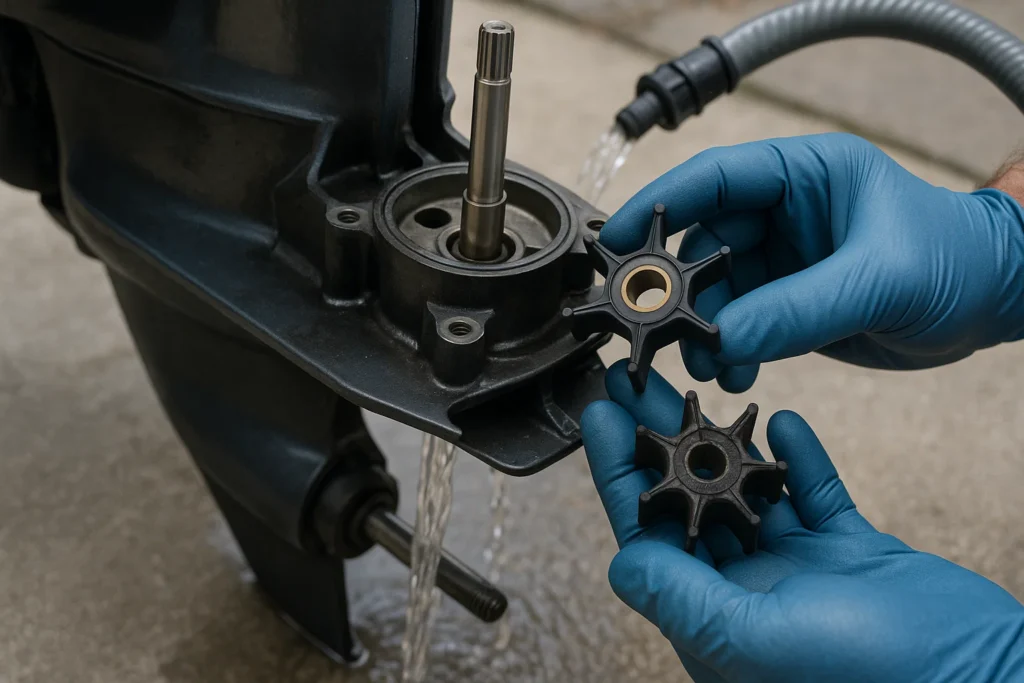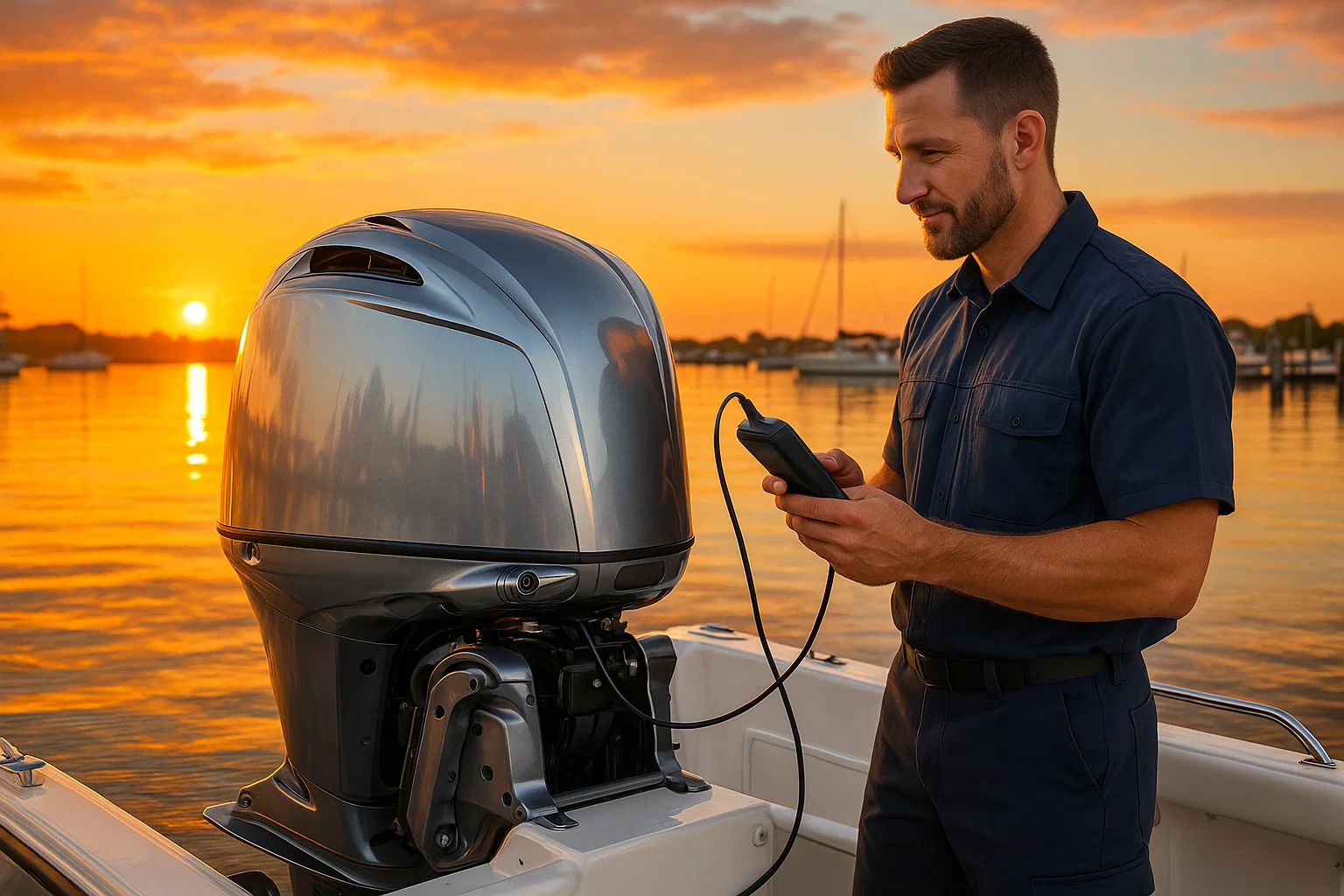Key Takeaways
Keeping your outboard engine reliable comes down to accurate diagnosis, understanding common failure points, and embracing smart, preventative maintenance. This guide demystifies expert repair, giving you the knowledge to keep your engine running smoothly and troubleshoot with confidence. Here are the essential insights to get you back on the water, fast.
- Trust a systematic diagnosis that moves from simple visual checks to non-negotiable first steps like a full compression test to find the true root cause of any issue.
- Focus on the “Big Four” for efficient troubleshooting, as nearly every outboard problem can be traced back to the fuel, spark, cooling, or compression systems.
- Prioritize the fuel system first because a huge number of performance issues stem from bad fuel or clogs; professional ultrasonic cleaning is far more effective than simple sprays.
- Analyze spark quality, not just its presence, by looking for a strong, consistent blue spark and always checking for overlooked culprits like corroded ground wires.
- Prevent engine meltdown by recognizing that the number one cause of overheating is a failed water pump impeller—an essential part to replace as preventative maintenance.
- Invest in proactive maintenance with a critical three-year service that replaces the water pump impeller and thermostat to prevent the most common catastrophic failures.
- Be your own first line of defense by always using a quality fuel stabilizer and carrying a small toolkit with essential spares like plugs and a fuel filter.
Dive into our full guide to see how our expert process can save you time and money, ensuring your engine is ready for every adventure.
Introduction
There’s a specific kind of silence when an outboard engine sputters and dies miles from the dock. It’s a feeling of frustration that can ruin a perfect day on the water and spark anxiety about costly, uncertain repairs.
Getting you back out there fast isn’t about making lucky guesses or just throwing new parts at the problem. It’s about a methodical process that finds the true root cause, guaranteeing a reliable fix that lasts.
True confidence on the water comes from knowing your engine was repaired with precision, not just patched up for the next trip. That’s why we don’t guess—we diagnose.
In this guide, we’ll pull back the curtain on our expert repair process. You’ll see exactly how we:
- Pinpoint the exact problem with a systematic diagnostic deep-dive.
- Solve the “Big Four” failures that plague nearly every outboard.
- Provide proactive maintenance that prevents breakdowns in the first place.
It all begins with a clear, accurate diagnosis. Here’s how we find the real issue from the very start.
The Diagnostic Deep Dive: How We Pinpoint the Exact Problem
A reliable repair starts with an accurate diagnosis. Throwing parts at an engine is a recipe for frustration, while a systematic approach ensures we find the true root cause of the problem before any work begins.
Our process is about being precise, not making educated guesses.
The First Five Minutes: Initial Assessment
Before we connect a single tool, we perform a thorough visual and manual inspection. This initial check often reveals the most common culprits and sets the direction for our technical diagnostics.
- Kill Switch & Gear Check: We immediately confirm the kill switch is securely connected and that the engine is in neutral. These simple oversights are surprisingly common causes of a no-start condition.
- Propeller and Fuel Line Inspection: We check the propeller for tangled lines or damage and give the fuel primer bulb a squeeze. A soft bulb or visible fuel issue gives us immediate clues.
Beyond the Basics: Advanced Testing Protocol
Once the initial checks are complete, we move to our comprehensive diagnostic testing. This is where expertise and specialized equipment uncover hidden issues.
- Compression Testing: This is a non-negotiable first step. We perform a full compression test on all cylinders, as low or uneven compression indicates serious internal problems that must be addressed first.
- Spark Quality Analysis: We don’t just check for a spark; we analyze its quality. We look for a strong, consistent blue spark. A weak, yellow, or intermittent spark points directly to ignition system faults.
- Fuel System & ECU Diagnostics: We test fuel pressure and check for contamination. For modern EFI engines, we connect directly to the Engine Control Unit (ECU) to read fault codes and review engine history with 100% accuracy.
This methodical, multi-step diagnostic process ensures we fix the right problem the first time, saving you money and getting you back on the water with confidence.

The “Big Four” of Outboard Failures: Fuel, Spark, Cooling, and Compression
Nearly every outboard issue can be traced back to one of four fundamental systems.
Understanding how we tackle each one shows you how we methodically solve even the most stubborn engine problems. We’ve built our reputation on mastering these core repair areas.
Fuel System Foul-Ups: The Usual Suspect
A staggering number of performance issues—from hard starting to sputtering at speed—stem from the fuel system. An engine that’s starved of clean fuel simply cannot run properly.
- Clog Removal: Old fuel turns to varnish, gumming up carburetors and fuel injectors. We use professional ultrasonic cleaning to completely restore these parts, which is far more effective than a simple spray cleaner.
- Flow Restoration: We trace the entire fuel path, replacing clogged filters, clearing pinched lines, and testing the fuel pump to ensure it delivers fuel at the correct pressure.
- Decontamination: If we find water or debris, we can perform a full tank drain and cleaning to stop the problem from coming right back.
Electrical Gremlins: Chasing a Healthy Spark
Electrical problems can be frustratingly intermittent. Our process logically traces the issue from the spark plug back to its source. We don’t just check for a spark; we analyze its quality.
A weak, orange spark is just as bad as no spark at all. We look for a strong, consistent blue spark, which indicates a healthy ignition. Often, the fix is simpler than you’d think—corroded ground wires are a frequent and overlooked cause of a weak or absent spark.
Keeping It Cool: Preventing Engine Meltdown
Overheating is one of the fastest ways to cause catastrophic engine damage. We treat the cooling system as a top priority in both repairs and preventative maintenance.
The number one cause of overheating is a failed water pump impeller. This small rubber part becomes brittle over time and should be replaced regularly.
- Impeller Replacement: We consider this essential preventative maintenance.
- Blockage Clearing: We flush the entire cooling path to remove salt, sand, or old impeller fragments.
- Thermostat Testing: A stuck thermostat can cause the engine to run too hot or cold, so we test and replace it to ensure optimal operating temperature.
By methodically addressing fuel, spark, and cooling, we can diagnose nearly any issue with precision. This systematic approach ensures we fix the right problem the first time, getting you back on the water without guesswork.
Beyond the Basics: Advanced Mechanical and Structural Repairs
Sometimes, the problem goes deeper than a simple tune-up. When a major component fails, you need a shop equipped to handle intensive mechanical repairs that others might turn away.
This is where our deep engine knowledge truly shines, tackling the complex jobs that bring an engine back from the brink.
Lower Unit and Gearcase Restoration
The lower unit lives a tough life, operating completely submerged and bearing the brunt of underwater impacts. We specialize in restoring this critical component to factory-spec condition.
- Seal and Bearing Replacement: Water intrusion is a common killer of lower units. We perform a complete disassembly, replace every seal, and pressure-test the gearcase to guarantee it’s perfectly watertight. This service also addresses worn bearings that cause grinding noises.
- Driveshaft and Prop Shaft Straightening: A minor impact with a rock can bend a prop shaft, causing performance-robbing vibration. Our specialized tools can diagnose and straighten bent shafts with precision, saving you the high cost of a full replacement.
- Gear and Clutch Dog Repair: Does your engine jump out of gear or make a loud clunk when shifting? That’s a classic sign of worn internal gears. We can replace these components, restoring the smooth, reliable shifting you depend on.
Powerhead Surgery: Internal Engine Work
When a compression test reveals serious internal damage, a full engine teardown is often the only solution. We have the clean-room environment and expertise required for these intricate rebuilds.
- Piston, Ring, and Cylinder Service: We resolve issues like scored cylinder walls and broken piston rings that cause a critical loss of power and compression. This can involve honing cylinders or boring them for a fresh start.
- Head Gasket Replacement: A blown head gasket can cause catastrophic overheating by allowing water into the cylinders. This intensive repair requires removing the powerhead and machining the cylinder head surface to ensure it’s perfectly flat for a lasting seal.
Handling these advanced repairs isn’t just about replacing parts; it’s about restoring the core integrity of your engine for years of reliable performance.

Proactive Maintenance: Your Best Defense Against Breakdowns
The most affordable repair is the one you never have to make. A strategic maintenance plan is the key to enjoying a reliable outboard and avoiding surprise failures on the water.
We partner with you to create a schedule that protects your investment and maximizes your time boating, not troubleshooting.
A Custom Maintenance Plan
Your boating style dictates your maintenance needs. A high-hour fisherman has different requirements than a casual weekend cruiser, so we tailor our recommendations directly to you and your engine.
This isn’t about unnecessary work; it’s about smart prevention.
- Annual Service Essentials: This forms the foundation of reliability. It includes an engine oil change (for four-strokes), gearcase lube change, fuel filter replacement, and fresh spark plugs.
- The Critical Three-Year Service: This is where we prevent the most common catastrophic failures. The cornerstone of this service is replacing the water pump impeller and thermostat, as a failed impeller is the number one cause of overheating.
- Fuel System Preservation: Today’s ethanol-blended fuels can wreak havoc when a boat sits. We strongly advocate for using a quality fuel stabilizer with every fill-up to prevent clogs and corrosion.
Your Onboard Toolkit for Peace of Mind
Being prepared for minor issues on the water can turn a potential disaster into a minor inconvenience. A small, well-stocked toolkit is essential.
- The Must-Have Spares: We recommend every boater carry spare spark plugs, a spare fuel filter, and an extra propeller nut and cotter pin.
- Basic Troubleshooting Tools: A simple kit with a spark plug socket, a multi-bit screwdriver, pliers, and a basic wrench set is often all you need for a quick fix.
- Knowledge is Power: Your engine’s most valuable tool is your service manual. Understanding its basic troubleshooting charts can help you diagnose and fix simple problems on the spot.
A little preparation on land makes for a lot more confidence on the water. Following a strategic maintenance schedule is your ticket to a stress-free season, ensuring your engine is ready right when you are.
Conclusion
Your outboard engine is the heart of your time on the water. Keeping it in peak condition isn’t about avoiding problems—it’s about ensuring every trip is smooth, reliable, and stress-free.
True confidence on the water comes from knowing your engine has been cared for with expertise, from methodical diagnosis to proactive maintenance.
Here are the key takeaways for a trouble-free season:
- Prevention is the Best Policy: Proactive maintenance is always cheaper than a breakdown. The water pump impeller and thermostat are the most critical components to replace on schedule.
- Fuel is Your Foundation: The majority of running issues start with old or contaminated fuel. Using a quality fuel stabilizer is a simple, powerful way to prevent clogs.
- A Real Diagnosis Saves Money: Never just throw parts at a problem. A systematic diagnostic approach pinpoints the true root cause, preventing wasted time and unnecessary expenses.
- Be Your Own First Responder: A small, well-stocked onboard toolkit with spare plugs and filters can turn a potential disaster into a minor fix.
Your path to a reliable boating season starts with a single step. Look at your logbook—when was your last full service? If you’re facing an ongoing issue, stop guessing and schedule a professional diagnostic with our team.
Don’t let engine trouble dictate your time on the water. Invest in your engine’s health today, and it will reward you with a season of perfect starts and unforgettable memories. Your boat is ready for the water; let’s make sure your engine is too.


Leave a Reply